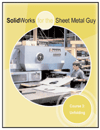
A chilled beam installation at the Charles H. Townes Center for Science at Furman University in South Carolina is forecast to save the university 31% in energy costs, which equals $55,000.
A 2006-08 addition and renovation to the Charles H. Townes Center for Science complex at Furman University in Greenville, SC, effectively catapulted the original 1950’s structure into the 21st century. At the center of this renovation was the application of 1,600 SEMCO Flexicool® active chilled beams, installed throughout the new building in labs, classrooms, and offices. With integrated lighting options, inherent modularity, and a unique airflow pattern control feature, these beams were adapted to suit the intended use of individual rooms.
Chilled beam technology allowed Ballinger Architects and Engineers (Philadelphia) to significantly reduce the amount of air delivered to the facility spaces. The decision to use chilled beams instead of a typical VAV system enabled the university to cut their sheet metal costs in half and will save Furman over $50K in energy costs each year.
Ironically, it wasn’t the savings that led Ballinger to explore chilled beams. It was architecture. Because part of the renovation involved the existing 1950s building, the engineers had very little floor-to-floor height to work with in laying out ductwork. This lack of space led the engineers to chilled beams. The question was: Could a chilled beam system operate effectively in the southeast, where high humidity is a factor? Chilled beams satisfy sensible loads only, so condensation could be a problem if the supply air was not sufficiently dehumidified.<
VAV Alternative
Chilled beams are not a new technology; they have been in use in Australia and European countries for nearly two decades. However, they have only recently been introduced to the U.S. by SEMCO Incorporated. Until Furman University, there had never been an application in the coastal southeast.Active chilled beams are installed in either the ceiling space or exposed in spaces with no ceilings and provide both cooling and ventilation. Air from the primary building supply enters the beam and is directed downward via a series of openings, which may be adjusted to control the velocity, pressure and throw of the air. Cooling is the result of the secondary chilled water loop, which circulates through the beams as needed to cool the room.
Each space is provided with a chilled water control valve for individual temperature control. As cool air leaves the beam through the openings on either side of its length, warm room air is drawn back through the center of the beam by induction where it gives its heat up to the chilled water loop. The control system continuously monitors room temperature and humidity conditions as well as the chilled beam loop temperature. If the chilled beam loop temperature approaches the room dewpoint condition, the chilled beam room valve modulates closed.
Because water is a more effective heat transfer medium than air, a system with chilled beams typically requires 40% to 70% less cfm. This reduction in forced air results in a system that is more comfortable (evenly dispersed air eliminates drafty areas) and quieter than a typical VAV system. Patented control rails can adjust the size of the openings along the length of the beam’s supply air channel. This adjustable slot size permits different cooling performance from the same beam, as well as different air diffusion options.
Less cfm means less horsepower, which will adds up to major lifetime savings. Ballinger’s modeling showed a typical VAV system for Furman would have required 250,000 cfm compared to the 165,000 cfm required for the chilled beam system.
“We estimated a reduction of $55,000 in overall energy cost per year which equals a 31% savings,” said Shapiro, the lead mechanical engineer for Ballinger. This made chilled beams a clear choice for Furman.
Keeping Supply Air Dry
One of the keys to the success of this design is ensuring dry supply air. To remove moisture and pre-condition incoming outside air, the main air handlers at Furman incorporate SEMCO total energy recovery wheels, which transfer both latent and sensible energy from the exhaust airstream to the supply airstream. The energy recovery wheels dehumidify the supply air upstream of the chilled water coils from 97.0 db/74.0 wb (approximately 121 grains of moisture per pound of air) to a condition of 79.0 db/64.4 wb (66 grains) on a design day. This takes approximately an 800-ton load off the campus chilled water plant. The chilled water coils take the supply air to a condition of 53.4 db/52.7 wb (58 grains). The energy recovery wheels ensure that cool, dry air is delivered to the chilled beams as primary air.“This is really a benchmark application for chilled beams,” remarked Redderson. “Furman is extremely excited and proud to have demonstrated that this is a viable, energy saving option, even in the humid South.”ES







